Microsoft Surface Pro 3 Review
by Anand Lal Shimpi on June 23, 2014 3:55 AM ESTDisplay Analysis
I published an analysis of Surface Pro 3's display shortly after receiving my review unit. For those of who you haven't seen it already, the results and analysis are reprinted below.
With Surface Pro 3, Microsoft finally accepts that while 16:9 may be a great aspect ratio for watching movies but it's not optimal for a multi-purpose tablet. The tablet features a 12" 2160 x 1440 display (RGB stripe, not RGBW/PenTile), which ends up being a 3:2 aspect ratio. The difference is immediately noticeable in notebook-style use. While the Surface Pro 2 was never quite all that comfortable to use as a laptop, Surface Pro 3's display makes it substantially more laptop-like. There doesn't appear to be a big impact to tablet use either with the larger display. Particularly with Windows 8.1's split screen mode, the larger display ends up working extremely well. The LCD continues to be laminated to the cover glass just like with previous Surfaces.
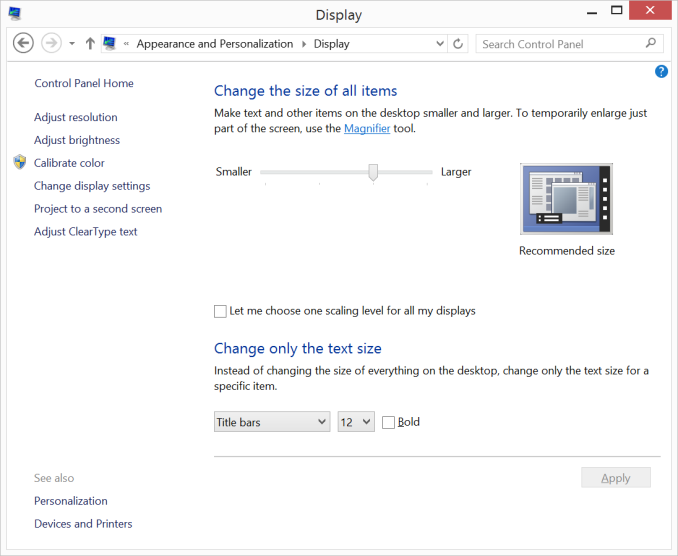
Default 150% Scaling on Surface Pro 3, the 2160 x 1440 display behaves like a HiDPI 1440 x 900 display
Color accuracy is improved out of the box as well. The original Surface Pro had a display capable of being quite accurate, if calibrated, but out of the box it was a bit of a mess. Microsoft slowly improved out of box calibration over the years, eventually culminating in what we have today with Surface Pro 3.

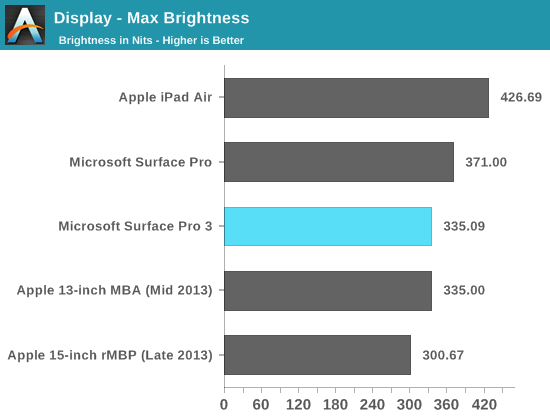
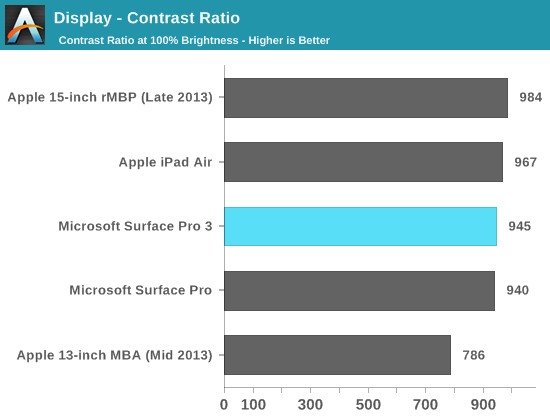
Max brightness drops a bit compared to Surface Pro 2, likely due to the Pro 3 having 50% more pixels to light. Black levels at max brightness are pretty good, thanks in part to Microsoft's optically bonded LCD/cover glass stack. Contrast ratio remains competitive with previous designs.
Grayscale accuracy is the biggest issue with the new display, green levels are just way too high:
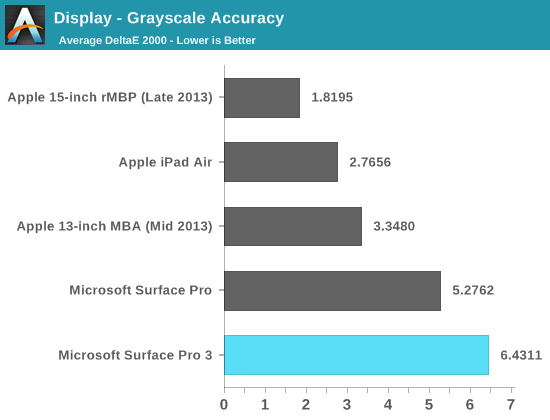
Our basic sRGB gamut test paints a great picture for Surface Pro 3. Full saturation color reproduction is excellent:
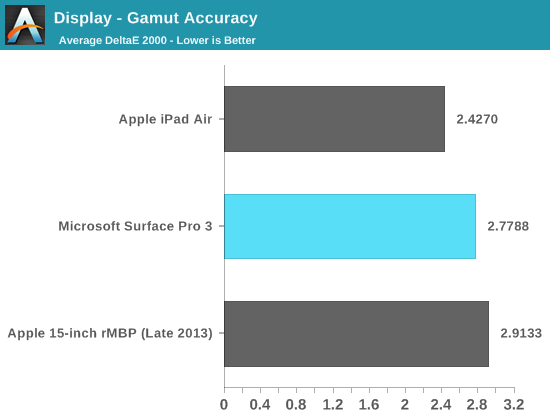
The saturation sweep also looks solid:
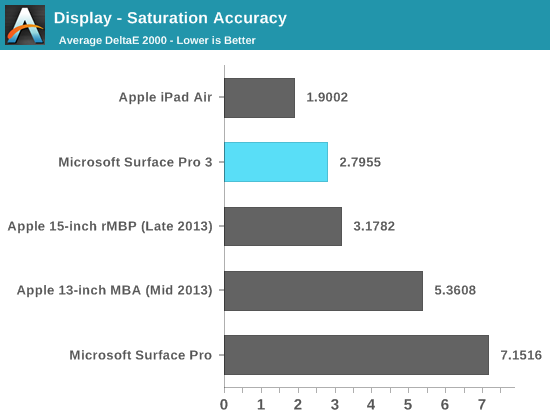
Unfortunately Surface Pro 3 doesn't do so well on our GMB color checker test. Part of the problem is its performance in the grayscale swatches included in this test:

Overall the Surface Pro 3 display is a huge improvement over the previous two generations, but it doesn't quite meet the high standards set by some of the other competitors on the market today from both notebook and tablet spaces.


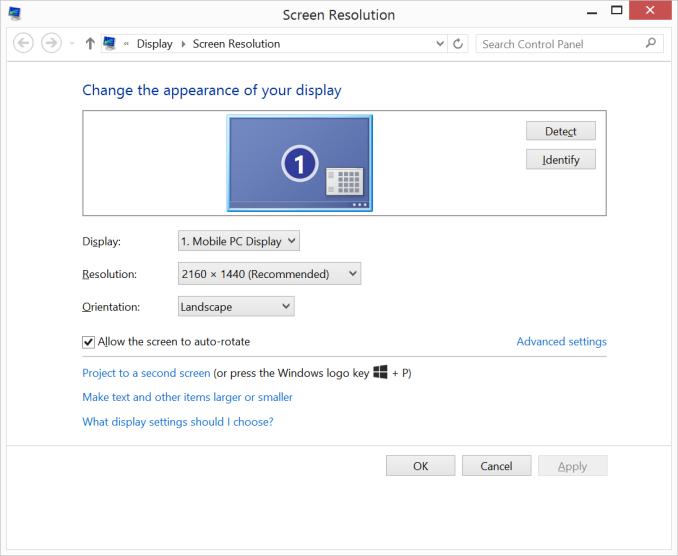



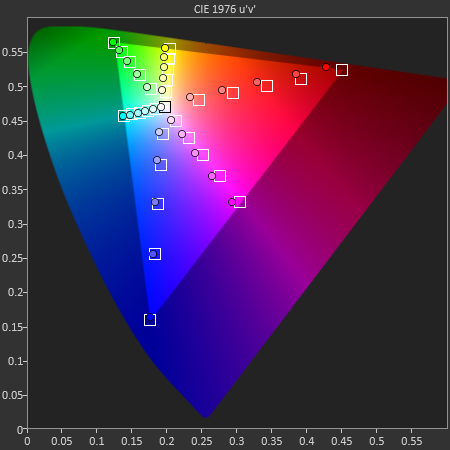










274 Comments
View All Comments
Walkop - Wednesday, September 17, 2014 - link
Edit: never , I see you meant now.Walkop - Wednesday, September 17, 2014 - link
Stupid Chrome Beta and gesture keyboards… *never mind, *see whatWalkop - Wednesday, September 17, 2014 - link
No.The Surface Pro's aspect ratio gives it a bigger display area than both MacBook Air's.
Sabresiberian - Monday, June 23, 2014 - link
I don't understand why you need a comparison written as an article. You are certainly capable of doing it for yourself - and have. :)Tegeril - Monday, June 23, 2014 - link
"TypeCover=1095g" when Macbook Air 11 is 108x grams but represented in kg suggests some sort of odd agenda, if you ask me.drmyfore - Tuesday, June 24, 2014 - link
Surface Pro 3 / 7.6V 42.2Whr 5547mAhMacbook Air 11 / 7.6V 38.75Whr 5100mAh
Macbook Air 13 / 7.6V 54.4Whr 7150mAh
Obviously, in battery life test, the MBA 11 is more appropriate than MBA 13.
name99 - Tuesday, June 24, 2014 - link
I think the more interesting comparison is with iPad Air.Basically (depending on the details) it's 2 to 3x as fast, with 3x tending to kick in when hyper threading is useful. How long does that advantage last?
The speed bump from A5 to Swift was about 2x, split between about 1.6x frequency improvement and 1.2x µarchitecture improvement. This accompanied a 45 to 32nm process change.
Swift to Cyclone was about a 1.5x improvement, all in architecture and µarchitecture, with a minor process improvement (32nm to 28nm HK).
A8 is expected to be a substantial process improvement (20nm, but still not FinFet). Personally I think this round the big changes will be in an Apple branded graphics cell and in the uncore, with minor changes in the core, but from process we should expect about a 1.5x boost, with obvious frequencies being 1.8 or 2GHz. So with the A8 round Apple does not hit Haswell, but gets a lot closer. Of course we then get Broadwell, but we expect Broadwell to be what, a 1.1x speedup or so?
IF Apple decides this is the year to switch to three cores rather than 2 that gives us a further factor of 1.5x (for that fraction of benchmarks that are substantially parallel) and we get even closer.
I'm on the fence about whether this makes sense yet, but Apple tends to design for products that stay relevant for 4yrs or so; and if they believe they're going to achieve substantially more parallelism over the next 4 yrs, it may make sense to do this now. They may also feel the marketing pressure is becoming problematic given the supposed China love of extra cores. They may also, this round, give us an A8X variant for iPads with three cores, keeping the phone A8 at two cores?
One final point is that, as Apple has methodically reached into the standard bag of "how to improve your CPU" tricks, one trick they have not yet used is that of putting a very small PMC on die to control turbo-ing --- like all ARM they're still doing everything in SW.
It seems obvious that at some point this will change, and the A8 may be the SoC where it changes. Ultimately such a change will allow Apple to get closer to Intel simply because it will be able to do the same sort of short high-speed thermally limited sprints that Intel can do. Of course it took Intel quite some time to get from the first generation of PMCs to today's sophisticated monsters that take into account things like thermal inertia, so one should expect that Apple's first attempt will not be nearly as aggressive as Intel --- though by the third attempt ...
Narg - Wednesday, July 30, 2014 - link
Why compare it to a Mac at all??? Most consumers won't bother with this, either they want Mac or they don't. It'd be better to compare it to say a Dell or Lenovo ultra/tablet/mix/something.coolhardware - Tuesday, June 24, 2014 - link
Interesting how few devices have a 3:2 aspect ratio, I notice the Nook HD+ as one and of course the Surface Pro 3 as another:http://pixensity.com/list/tablet/
I had the Nook HD+ and it is a very nice ratio IMHO (not too wide, not too tall).
I more Android tablets would start going 3:2 or 4:3 as I find it to be very beneficial for productivity work.
PS for movie viewing the ratio is not ideal, but in those cases I often just zoom in to fill the entire screen.
mmrezaie - Monday, June 23, 2014 - link
I tested it couple of times but I cannot get around the fact that this is still a beta, and they are asking too much for the price. I would rather go for thinkpad X or macbook air. Touch on Win8 is still a joke, and no homogeneity in software side.